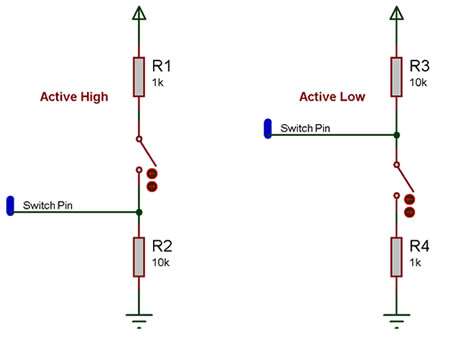Component: Switch Array Template (Switches)
| Author | Matrix Ltd. |
| Version | 2.0 |
| Category | Switches |
Contents
Switch Array Template component
A base component for creating an evenly spaced array of switches. Each will be connected to sequential pins of a given I/O port. Set target object to point at any standard switch component to change the type of switch used by the array.
Component Pack
BASICIO
Detailed description
No detailed description exists yet for this component
Examples
Here is an example Flowcode program to read the values of a switch array.
![]() Switch Array
Here is a schematic of how to connect a basic switch to a microcontroller pin.
Switch Array
Here is a schematic of how to connect a basic switch to a microcontroller pin.
The active high circuit will pass a logical 0 to the input pin when the switch is not pressed and a logical 1 when the switch is pressed.
The active low circuit will pass a logical 1 to the input pin when the switch is not pressed and a logical 0 when the switch is pressed.
There are some differences depending on the type of switch you have, the above states assume a generic push to make type switch, however a push to break type switch would have reversed logic and a toggle switch can work well with either setup.
The resistors are required for correct operation because when a microcontroller's input pin is essentially connected to nothing it will pick up noise in the environment and provide inconsistent readings. This state is referred to as floating i.e. the pin is floating. To test this remove the resistors (if possible) and touch the unconnected switch pins with your finger the output LEDs from the example file above will toggle on and off at high speed.
Any values of resistor can be used but it is important to keep the smaller resistor at least 10X smaller then the larger resistor to ensure that the pressed state provides at least 0.91% of the required pressed state voltage. For example a active high switch circuit using 1K and 10K resistors should pull up to about 4.54V when the switch is pressed.
(5V / 11K) * 10K = 4.54545V
Downloadable macro reference
| ReadState | |
| Read the state of the switch at the given index. | |
| Index | |
| The switch to read the status of. | |
| Return | |
| WaitUntilHigh | |
| Pause the program until the switch at the given index is turned on. | |
| Index | |
| Index of the switch to wait for. | |
| Return | |
| ReadAll | |
| Reads all of the switches at once, returning a byte containing one bit per switch. | |
| Return | |
| GetHandle | |
| Retrieves the object handle of the switch component at the given index. | |
| Index | |
| Return | |
| WaitUntilLow | |
| Pause the program until the switch at the given index is turned on. | |
| Index | |
| Index of the switch to wait for. | |
| Return | |
Property reference
| Properties | |
| Count | |
| The number of LEDs in the array from 1 to 8. | |
| Connections | |
| Input Mode | |
| Choose a single port for all LEDs - pins are allocated in sequence from pin 0 - 7 ...or choose 'Custom pins' to assign each switch individually. | |
| File:Fc9-type-19-icon.png | Port |
| Polarity | |
| Active High = LEDs light when the chosen chip pin is ON Active Low = LEDs light when the chosen chip pin is OFF | |
| Debounce | |
| Time in milliseconds allowed for the pin to settle following a change of state. | |
| Simulation | |
| Operation | |
| Sets whether switches toggle or are press/release. NB) This option can only be set when the original target includes this option. | |
| Alignment | |
| Which 3D axis to align the copies along. | |
| Spacing | |
| The distance between LEDs in the array. LEDs will be spaced symmetrically around the component centre. Use a negative value to reverse the order of the LEDs. | |
| Reverse | |
| Whether to reverse the order of the switches. | |
| Show Labels | |
| Whether to show labels giving each switch's pin connection. | |
| Label color | |
| Color of the port and pin labels | |
| Shape | |
| Target Switch | |
| To use a custom switch design... - Drag any switch component onto the panel, or create your own using the 'Switch base' - Give your new switch a memorable name. - Choose the new switch in this property; copies will be made to fill the array, and the original is hidden. When unconnected, it will use a default 'basic switch'. | |
